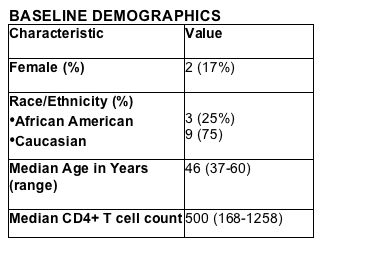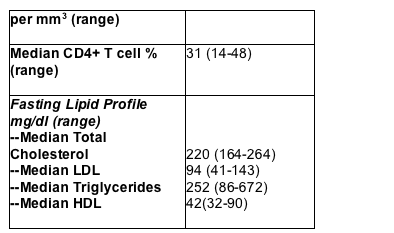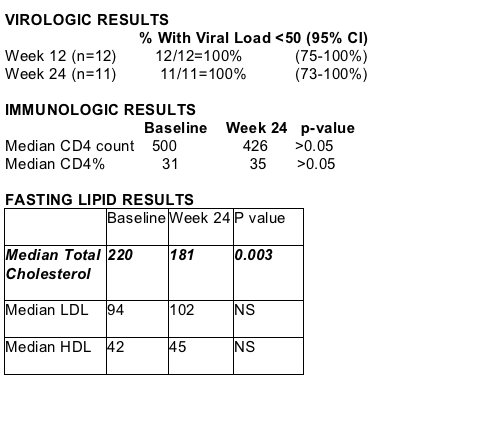 |
 |
 |
| |
The StARS Study: Once Daily Atazanavir, Low-Dose Ritonavir
and Saquinavir :
24 Week Efficacy, PK, and Safety Results
|
| |
| |
Reported by Jules Levin
Colson A1, Hellinger J1, Cohen C1, McLaughlin K1, Morris A2, Habel A1
Community Research Initiative of New England
1Boston, MA, USA; 2Springfield, MA, USA
There are a number of strategies for patients with drug resistance including new protease inhibitors tipranavir/r and TMC114/r. Both of these boosted protease inhibitors are potent and effective in suppressing HIV RNA for patients with extensive ART drug resistance. Prior to the recent availability of tipranavir/r dual boosted protease inhibitors were being used for patients with extensive drug resistance and few treatment options. German researchers explored ritonavir-boosted dual PI regimens without nukes for patients with extensive nuke resistance and this regimen was also found to be potent. There has never been direct study comparisons of the potency and efficacy of dual ritonavir boosted PIs and tipranavir/r or TMC114/r. In this pilot study presented in a poster at IAS-Rio (July 2005) researchers & Roche examine the a novel approach with a once daily ritonavir boosted dual PI regimen of atazanavir + lopinavir, boosted with low-dose ritonavir. CT results to evaluate body fat are pending.
AUTHOR SUMMARY
--In this pilot study, patients suppressed on LPV/r and SQV (+/-NRTIs) maintained suppression after substituting ATV/r for LPV/r and changing twice daily SQV to once daily SQV (1200-1600 mg QD)
--The median total cholesterol declined from a baseline of 220 mg/dl to 181 mg/dl (p=0.003) and the median fasting triglyceride declined from a baseline of 252 mg/dl to 168 mg/dl (p=0.006) at week 24
--At week 24, trough SQV levels were within target range at both doses studied (1200 mg QD and 1600 mg QD)
--This new regimen of dual boosted ATV/SQV/r once daily warrants further study in both na´ve, PI na´ve, and PI experienced patients
--It is uncertain to what extent the observed activity is attributed to the use of 2 boosted PIs versus either one alone
--CT results to evaluate body fat distribution will be repeated at week 48 and compared to baseline
Atazanavir/ritonavir (300/100 mg once daily) and lopinavir/ritonavir (400/100 mg twice daily) (Kaletra) have good efficacy in protease-inhibitor experienced patients. Compared to other protease inhibitors, atazanavir has less effect on plasma lipid profiles, even with ritonavir boosting. Atazanavir acts as a second booster for saquinavir (15th IAS Abstract WeOrB1235). There is a preference among patients for once daily dosing and low pill burden.
12 adults with viral load suppression (ultrasensitive assay) on a dual boosted PI regimen containing saquinavir and lopinavir/r (alone or in combination with NRTIs) for at least 12 weeks were switched to dual boosted PI regimen of atazananavir+liponavir/r
The objective for this study was to see if patients with sustained virologic suppression on a dual boosted PI regimen containing LPV/r and SQV, will maintain suppression after LPV/r/SQV is changed to ATV/SQV/r and to see if the plasma lipid profile will improve when LPV/r/SQV is changed to ATV/SQV/r.
At enrollment, all subjects changed from BID (twice daily) saquinavir and lopinavir/r to saquinavir hard-gel capsules 1200 mg once daily, atazanavir 300 mg once daily, and ritonavir 100 mg once daily. NRTIs, if present, were continued. After 2 weeks, the saquinavir dose was increased to 1600 mg once daily.
STUDY ANALYSES
--HIV RNA
--Fasting lipid profile
--Trough LPV and SQV levels at baseline
--Trough ATV and SQV levels after an observed dose at both SQV doses
--CT scans done at baseline and week 48 (wk 48 results pending)
Proportion with sustained virologic suppression at week 24 was calculated with a 95% confidence interval. Change from baseline to week 24 in CD4 counts and lipids was analyzed using the Wilcoxon Signed Rank Test.
BASELINE DEMOGRAPHICS


Accompanying nukes:
6 patients were taking no nukes
1 on 3TC
2 3TC/TDF
1 ABC/TDF
1 ABC/TDF
1 ABC/ddI
1 ddI/ABC/TDF
One subject withdrew from the study at week 12 due to pregnancy; her viral load was suppressed at the time of withdrawal. One subject reduced the SQV dose from 1600 to 1200 mg once daily at week 12 based on personal preference.


1 SQV dose = 1200 mg once daily ; 2 SQV dose = 1600 mg once daily
3 Acosta E et. al., AIDS Research and Human Retroviruses 2002, v18 (12): 825-834
Adverse effects
--No serious adverse effects
--Bilirubin showed expected increase; 3 participants had mild jaundice and 1 had moderate jaundice
--3 participants had mild diarrhea; 1 had moderate diarrhea
|
| |
|
 |
 |
|
|